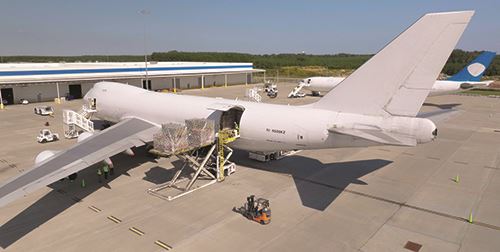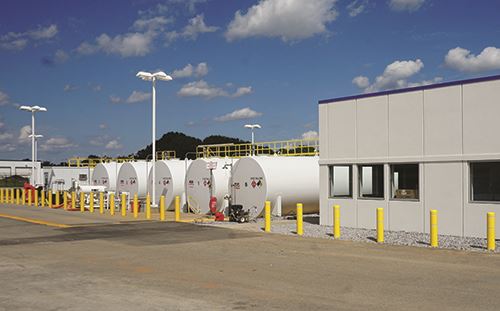Three years ago, officials at Greenville-Spartanburg International Airport (GSP) had a big challenge that needed to be addressed relatively quickly. The South Carolina airport had an ever-increasing demand for fuel, and its existing storage tanks could no longer meet that demand.
Three years ago, officials at Greenville-Spartanburg International Airport (GSP) had a big challenge that needed to be addressed relatively quickly. The South Carolina airport had an ever-increasing demand for fuel, and its existing storage tanks could no longer meet that demand. An expanded fuel station was imperative.
“Our airport had been growing steadily over the past few years, but cargo plane traffic has really soared,” states Senior Vice President and Chief Operating Officer Kevin Howell.
One of the main reasons for the surging cargo traffic is that BMW’s main auto assembly plant in North America is only three miles from the airport. And the company has a continual need to import various auto parts to South Carolina from its home base in Germany.
|
Project: Expansion of Fuel Tanks Dispensing System Location: Greenville-Spartanburg (SC) Int’l Airport Annual Operations (2022): 51,200 Commercial Airlines: Allegiant; American; Delta; United; Silver; Southwest Cargo Carriers: Amerijet; FedEx; Maersk; MasAir; UPS Project Cost: $5.5 million Funding: Airport cash reserves Key Components: New pair of 126,000-gal. Jet-A fuel tanks, which increased total storage capacity to 450,000 gal. Timetable: May 2021-Sept. 2022 Engineering & Design: Argus Consulting Main Contractor: Attaway Services Pipe Manufacturer: Traeger Brothers Tank Manufacturer: Tampa Tank Electrical Services: Attaway Services Carolina New Operations Building: Cely Construction Cathodic Protection: Allied Corrosion Fire Protection Engineering: Jensen Hughes Geotechnical Engineering: S&ME Civil/Concrete: Palm Beach Excavation Key Benefit: Significant increase in fuel storage capacity to meet surging demand from int’l cargo aircraft & commercial airlines |
Overall, GSP facilitates $5.5 billion worth of international trade, and it consistently ranks among the top 25 U.S. cargo airports in multiple recent surveys. Besides auto parts, cargo handlers at the airport process significant amounts of medical and agricultural supplies, as well as other heavy manufacturing components.
The airport handles all refueling for both cargo and passenger aircraft in-house. It began executing its own fueling operations in 2017 to allow more control of the customer experience, level of service and overall quality. (In a traditional contractual arrangement, an airport’s control is limited to what is spelled out in the contract.)
“When the Greenville-Spartanburg Airport District began to operate the FBO (Cerulean General Aviation), commercial fueling and aviation ground handling business lines, it put GSP in the driver seat,” says Howell. “If we want to provide a higher level of service, increase staffing, provide certain amenities, or expand or improve facilities, we decide how and when. There is risk and reward by taking this on at the airport, and we fully accept the responsibility.”
There is a steady demand for fuel with 15 international cargo operations per week by Maersk, additional ad-hoc charter cargo activity, six commercial airlines and active general aviation traffic. In fact, it takes eight fuel trucks to keep pace. And now that the pandemic is slowing, Howell expects airline traffic to continue growing steadily.
“The commercial segment comprises about 65% of our overall operations,” he shares. “We have to continue to keep those customers satisfied by having enough fuel available to meet their needs.”
Adding Capacity
With so many stakeholders depending on a steady supply of fuel, airport officials knew they had to increase on-field storage. By 2020, the airport’s old fuel station, which consisted of five 30,000-gallon tanks, could barely keep up with demand. “In some situations, we had fuel storage capacity for less than two days,” Howell recalls. “And when an unexpected disaster happened, as was the case a few years ago with the Colonial Pipeline shutdown, we had to bring in delivery trucks from all over the East Coast.”
In the early planning stages of the recent $5.5 million expansion project, airport officials knew that they had to at least double GSP’s storage capacity in short order. After reviewing multiple proposals for the project, the airport chose the design-build team of Argus Consulting and Attaway Services.
To win the contract, Argus and Attaway had to prove they could meet several criteria. Key project requirements included:
- At least 200,000 extra gallons of fuel storage needed to be added to supplement the airport’s existing 150,000 gallons of storage. Ultimately, two vertical tanks provided 252,000 more gallons of capacity.
- Construction could not impede the airport’s regular operations.
- Access to the fuel farm had to be configured so tractor-trailer trucks delivering fuel to the new storage tanks would not interfere with fueling trucks that service aircraft throughout the day.
- Designers had to leave room to accommodate two more vertical tanks for possible further expansion in the future.
- A new fuel station operations building had to be constructed within the fuel station complex.
The final, approved plans for the project called for two 32-foot-tall tanks, each capable of holding 126,000 gallons of Jet-A. The new vertical tanks are located near the old fuel station. A network of underground pipes connects the new tanks with the existing 30,000-gallon tanks.
A key element of the new design was determining how large outside fuel delivery trucks would get in and out of the station. A dedicated gate on the south side of the airfield was added for just this purpose. Meanwhile, the airport’s own trucks that deliver fuel to aircraft approach the fuel station from the north side of the property to reload their tanks before proceeding to parked aircraft.
 “This was a complicated process,” remarks Garrett Gjerstad, business unit director of general aviation for Argus. “Sometimes, six or seven large tractor trailers would make deliveries on the same day, while both commercial and cargo aircraft needed to be refueled at the same time.”
“This was a complicated process,” remarks Garrett Gjerstad, business unit director of general aviation for Argus. “Sometimes, six or seven large tractor trailers would make deliveries on the same day, while both commercial and cargo aircraft needed to be refueled at the same time.”
Project designers opted to locate the two new tanks in an empty field near the existing smaller tanks.
Stefen Rice, senior project manager for Attaway, notes that contractors faced their first challenge before construction began. “The ground at that site was filled with old soil and concrete chunks from previous projects,” he relates. “Our engineers determined that there would be way too much settlement to meet safety standards, especially for a large tank holding jet fuel. Therefore, we moved 20,000 cubic yards of material, and trucked in new engineered fill from the outside to use as the base.”
Tanks were erected in place; no off-site fabrication was done. The tricky part was connecting the new system to the existing tankage without disrupting operations. Much of this work occurred at night, during four-hour windows.
“There was a lot of welding, testing and drain-downs during these periods,” states Rice. “We had to install piping under the racetrack, which is the airport’s main artery for fuel trucks that service aircraft. We had to cut up the track, excavate it and then put in new asphalt.
“We ensured that the overnight work was completed within the given timeframe, and that airport operations would not be disrupted for the next morning’s flights.”
Once the tanks were erected, Attaway and Argus conducted a two-day training class for all airport employees who would be involved with the new tanks and associated systems. “The staff here was great to work with, and was already familiar with fueling operations. They were excited to use the new infrastructure we had constructed,” says Rice. “We also had weekly meetings throughout the duration of this project, so everyone remained informed and involved with the project’s execution.”

Safety Was a Priority
Rice stresses that safety procedures were vital throughout the project. “Nothing is simple in construction,” he affirms. “We had lots of moving parts every day. People were welding constantly. We might have from 20 to 40 people working at the same time.”

There also were steady concerns and cautions about dangerous vapors, especially when fuel hoses were connected to one of the original 30,000-gallon storage tanks. “We had to take extra precautions throughout the process,” Rice emphasizes. “We used meters to measure Lower Explosive Limits (LEL) in the atmosphere.”
After all components were installed and hooked up, a rigorous one-week testing period began. Specialists checked the tanks, pipe-to-pipe fittings, fuel flushing performance, etc.
The jet fuel itself was tested to ensure there were no harmful particulates. “We did a 16-point inspection. All 16 tests had to be passed by an independent third-party lab,” Rice says. “We even hired our own lab as a backup.”
Safety procedures concerning airfield traffic also were important, Gjerstad adds. “Naturally, we wanted everything to be safe, and we designed systems that would eliminate obstacles. There were many stages of security. For example, contractors needed various badges, and had to be escorted by airport staff. They also had to enter the airfield from a security gate at the south end of the airfield.”
Well-Oiled Machine
The new storage tanks receive product from fuel delivery trucks that originate at various stations throughout the Southeast. Each day, one tank is in “receiving” mode while the other is in “settling” mode. It’s standard practice to allow fuel to settle so unwanted sediment isn’t pumped into fueling trucks and then possibly into aircraft.
After the settling process is complete, the fuel farm operator sends the fuel to one of the airport’s five original horizontal tanks. Each airport fuel truck driver communicates with the fuel station manager on duty to learn which of the five horizontal tanks to use. During the refilling process, drivers work with the on-site manager to make sure the correct amount of fuel is sent to their vehicles. Sophisticated computerized gauges are used throughout the process.
When 747 cargo jets needed refueling, they usually require 20,000 gallons of fuel, which consumes most of one of the airport’s smaller 30,000-gallon tanks. When two or three of these jumbo jets land and need fuel, it is imperative that the process runs quickly
and smoothly.
The new fuel operations facility was built within the fuel station to help make sure that happens. A manager and two quality control personnel are based at the station. In addition, GSP employs about 15 people who drive and service the eight fuel trucks based at the airfield. The largest trucks have 10,000-gallon capacities, so fueling personnel use two trucks simultaneously to expedite service for 747 cargo jets.
These large international cargo aircraft often have turnaround times of just two to four hours. “They want to get serviced and refueled to allow the aircraft to move cargo to its next destination,” Howell explains. “Our experienced staff here can make that happen.”
Overcoming Challenges
Installing the stainless-steel piping between the new and old tanks added time to the schedule. “Larger airports such as GSP normally use carbon steel piping,” says Rice. “Welding stainless is a much slower process than that used for carbon steel.”
 Working at this busy airport while not disrupting operations was another challenge. “Scheduling changes were very frequent,” says Rice. “We had to schedule our work around planes that were late to arrive and/or had to be refueled to depart again. Staying flexible and reacting quickly was key.”
Working at this busy airport while not disrupting operations was another challenge. “Scheduling changes were very frequent,” says Rice. “We had to schedule our work around planes that were late to arrive and/or had to be refueled to depart again. Staying flexible and reacting quickly was key.”
Despite such challenges, GSP officials consider the tank installations a success. “This project went well, and we are very pleased,” Howell remarks. “Our contractors and design team did an excellent job, especially with a tight timetable.”
The airport’s added fuel capacity could prove to be very timely. “We expect cargo traffic to increase in the future,” says Howell. “BMW is expanding its auto factory here, and we are seeing more cargo traffic to South Korea, Mexico and other European countries. We are well prepared to meet the demand for more fuel from these aircraft. And with our 11,000-foot runway, we can handle any aircraft in the world.”




